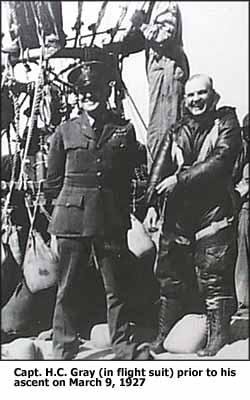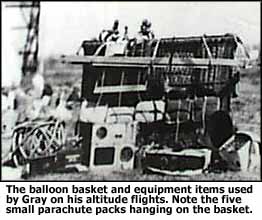OFFICIAL REPORT TO GENERAL PATRICK
WASHINGTON, November 5, 1927 – Major General Mason M. Patrick, Chief of the Army Air Corps today received the following report from the commander at Scott Field on thedeath of Captain Gray:
“Have confirmed report from Sparta, Tennessee, that Captain Gray died in his attempt for altitude. Indications are that he died in high altitude and no marks or violence of a crash on his body. Mrs. Gray desires that his body be buried at Arlington Cemetery. Request that all funeral arrangements be made for his burial. Will keep you informed. Four officers in planes went toS parta to take charge of the body and property.”
Considerable preparation was made during the last three weeks for Captain Gray’s third attempts at the altitude record. This included the development of the oxygen apparatus upon which the pilot depends for energy and existence at very high altitudes. On his previous flight it was found that the oxygen became cold at high altitudes and hampered to some extent the activity of the pilot. This it was believed had been overcome by a device for preheating the oxygen flow.
Since the least expenditure of energy at high altitudes is extremely fatiguing, every effort was made to devise equipment which will reduce to a minimum the pilot’s attempts in gaining maximum altitude. From tests conducted on cats, guinea pigs, rats and birds, it was determined that life can exist at an altitudeof 53,000 feet.
In all experiments with the various subjects it was found that the subject became unconscious at altitudes between 47,000 or 48,000 feet, with the exception of the rat, which retained consciousness to an altitude of about 56,000 feet, at which altitude the animal died.
Captain Gray had been piloting balloons since 1921. He was born in Washington State in 1889 and enlisted in the Army in 1915.
Yesterday’s News: Balloon pioneer died in record try
Courtesy of: Frank Boyett – Gleaner Community Columnist
November 3, 2002
Captain Hawthorne C. Gray’s trip to heaven in 1927 was the shortest on record.
When Gray died 75 years ago this week he was farther from the earth’s surface than any man had ever traveled. He is not particularly well remembered today, but he was a pioneer of high altitude flight and the U.S. Army Air Corps’ leading balloonist in 1927.
His last flight, which set off from Scott Field in Belleville, Illinois, November 4, 1927, was an attempt to set a new altitude record. He was successful, in that he reached a height of 42,740 feet, but he never reached the ground alive.
Exactly what went wrong remains a mystery to this day. A 1927 article about fatal aviation accidents published by the U.S. Air Services said, “The tragic end of Captain Gray’s brilliant career came under circumstances that probably never will be known…. The fact that his oxygen tube was severed, as if by a knife, led to the almost unanimous conclusion that, while ripping open sand bags, the knife accidentally cut the tube.”
So why am I telling you this? Because Henderson played a minor role in Gray’s historic ascent. Four escort planes accompanied Gray on his last flight, and two of them landed at Henderson after losing sight of Gray.
“Hurtling in from the west before a high wind at a speed of 120 miles an hour, the army planes circled Henderson, dropped to a low level and landed safely,” The Gleaner reported. “The fliers spent last night in the city and will probably attempt a take-off this morning.”
Keep in mind that airplanes were still something of a novelty in 1927; the first plane had been seen in this area only 15 years earlier. And the Army planes that landed here were some of the most advanced aircraft of their time, having been modified for flying at night.
The Douglas 0-02-A biplanes each carried two men. The plane piloted by Captain J. J. Devery of Chanute Field in Rantoul, Illinois, and Lieutenant H. H. Couch of Scott Field landed first, touching down about four miles east of town on Zion Road at 4:45 on a Friday afternoon. They were followed a few minutes later by Lieutenant S. W. Towle and a Sergeant Stinson, both of Scott Field, who landed about a mile away. The other two escort planes landed at Madisonville the same afternoon.
“Captain Devery stated last night that he lost sight of Captain Gray over Mt. Vernon, Illinois, as the balloon was engulfed by clouds,” The Gleaner reported. “The planes searched for more than an hour but were landed so the pilots could receive further orders.
“Captain Devery anticipates some difficulty in taking off today as a speed of 70 miles an hour is necessary to lift the big army planes. Whether that speed can be attained over a rough field is questionable.”
The planes took off the next day without incident, however, and proceeded to Sparta, Tennessee, where Gray’s balloon had landed with his body.
The fatal flight was Gray’s third attempt to break the world altitude record. On March 9, 1927, according to the U.S. Air Force Museum web site, “he lost consciousness at 27,000 feet because his oxygen equipment froze; he survived because his balloon luckily descended by itself. On May 4 he made another flight, this time reaching an altitude of 42,740 feet, a world record height. However, when he attempted to descend, the gas valve stuck in the open position and the balloon began falling, forcing Gray to parachute to safety.”
That altitude record was not official because the rules said a pilot had to be in control of his aircraft at the time he landed in order to set a new record. Coincidentally, the altitude he reached on May 4 was exactly the same as his barometer recorded on his final flight.
Gray’s last communication was when he recorded in his log book on November 4 that he had attained a height of 40,000, but his writing was shaky, indicating a lack of oxygen.
The Air Force museum notes that Gray’s attempt was “the last open-basket high-altitude balloon flight until 1955, when such projects were reinstated to develop pressure and space suits of a new era.”
In recognition of his three balloon flights Gray was posthumously awarded the Distinguished Flying Cross, a rare decoration in those days. He is buried in Arlington National Cemetery.
GRAY, HAWTHORNE C
- CAPT AC USA WASH
- DATE OF DEATH: 11/03/1927
- BURIED AT: SECTION 4 S SITE LOT 2601
ARLINGTON NATIONAL CEMETERY
Michael Robert Patterson was born in Arlington and is the son of a former officer of the US Army. So it was no wonder that sooner or later his interests drew him to American history and especially to American military history. Many of his articles can be found on renowned portals like the New York Times, Washingtonpost or Wikipedia.
Reviewed by: Michael Howard


